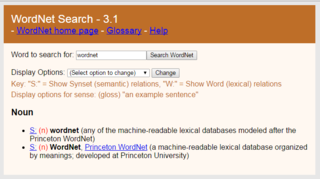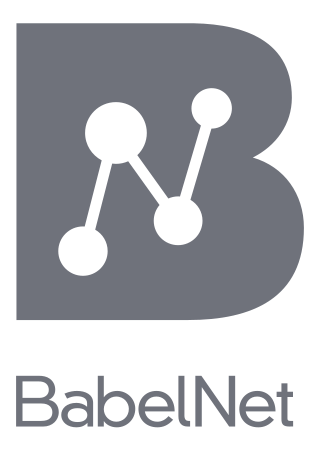In linguistics, declension is the changing of the form of a word, generally to express its syntactic function in the sentence, by way of some inflection. Declensions may apply to nouns, pronouns, adjectives, adverbs, and articles to indicate number, case, gender, and a number of other grammatical categories. Meanwhile, the inflectional change of verbs is called conjugation.

WordNet is a lexical database of semantic relations between words that links words into semantic relations including synonyms, hyponyms, and meronyms. The synonyms are grouped into synsets with short definitions and usage examples. It can thus be seen as a combination and extension of a dictionary and thesaurus. While it is accessible to human users via a web browser, its primary use is in automatic text analysis and artificial intelligence applications. It was first created in the English language and the English WordNet database and software tools have been released under a BSD style license and are freely available for download from that WordNet website. There are now WordNets in more than 200 languages.
An adjective is a word that describes or defines a noun or noun phrase. Its semantic role is to change information given by the noun.
An adverb is a word or an expression that generally modifies a verb, adjective, another adverb, determiner, clause, preposition, or sentence. Adverbs typically express manner, place, time, frequency, degree, level of certainty, etc., answering questions such as how, in what way, when, where, to what extent. This is called the adverbial function and may be performed by single words (adverbs) or by multi-word adverbial phrases and adverbial clauses.
In grammar, a part of speech or part-of-speech is a category of words that have similar grammatical properties. Words that are assigned to the same part of speech generally display similar syntactic behavior, sometimes similar morphological behavior in that they undergo inflection for similar properties and even similar semantic behavior. Commonly listed English parts of speech are noun, verb, adjective, adverb, pronoun, preposition, conjunction, interjection, numeral, article, and determiner.

A synonym is a word, morpheme, or phrase that means exactly or nearly the same as another word, morpheme, or phrase in a given language. For example, in the English language, the words begin, start, commence, and initiate are all synonyms of one another: they are synonymous. The standard test for synonymy is substitution: one form can be replaced by another in a sentence without changing its meaning. Words are considered synonymous in only one particular sense: for example, long and extended in the context long time or extended time are synonymous, but long cannot be used in the phrase extended family. Synonyms with exactly the same meaning share a seme or denotational sememe, whereas those with inexactly similar meanings share a broader denotational or connotational sememe and thus overlap within a semantic field. The former are sometimes called cognitive synonyms and the latter, near-synonyms, plesionyms or poecilonyms.
In lexical semantics, opposites are words lying in an inherently incompatible binary relationship. For example, something that is long entails that it is not short. It is referred to as a 'binary' relationship because there are two members in a set of opposites. The relationship between opposites is known as opposition. A member of a pair of opposites can generally be determined by the question What is the opposite of X ?
Linguistics is the scientific study of human language. Someone who engages in this study is called a linguist. See also the Outline of linguistics, the List of phonetics topics, the List of linguists, and the List of cognitive science topics. Articles related to linguistics include:
Lexical semantics, as a subfield of linguistic semantics, is the study of word meanings. It includes the study of how words structure their meaning, how they act in grammar and compositionality, and the relationships between the distinct senses and uses of a word.
In linguistics, a modifier is an optional element in phrase structure or clause structure which modifies the meaning of another element in the structure. For instance, the adjective "red" acts as a modifier in the noun phrase "red ball", providing extra details about which particular ball is being referred to. Similarly, the adverb "quickly" acts as a modifier in the verb phrase "run quickly". Modification can be considered a high-level domain of the functions of language, on par with predication and reference.
In generative linguistics, Distributed Morphology is a theoretical framework introduced in 1993 by Morris Halle and Alec Marantz. The central claim of Distributed Morphology is that there is no divide between the construction of words and sentences. The syntax is the single generative engine that forms sound-meaning correspondences, both complex phrases and complex words. This approach challenges the traditional notion of the Lexicon as the unit where derived words are formed and idiosyncratic word-meaning correspondences are stored. In Distributed Morphology there is no unified Lexicon as in earlier generative treatments of word-formation. Rather, the functions that other theories ascribe to the Lexicon are distributed among other components of the grammar.
Syntax is concerned with the way sentences are constructed from smaller parts, such as words and phrases. Two steps can be distinguished in the study of syntax. The first step is to identify different types of units in the stream of speech and writing. In natural languages, such units include sentences, phrases, and words. The second step is to analyze how these units build up larger patterns, and in particular to find general rules that govern the construction of sentences.http://people.dsv.su.se/~vadim/cmnew/chapter2/ch2_21.htm
In linguistics, a semantic field is a lexical set of words grouped semantically that refers to a specific subject. The term is also used in anthropology, computational semiotics, and technical exegesis.

English adverbs are words such as so, just, how, well, also, very, even, only, really, and why that head adverb phrases, and whose most typical members function as modifiers in verb phrases and clauses, along with adjective and adverb phrases. The category is highly heterogeneous, but a large number of the very typical members are derived from adjectives + the suffix -ly and modify any word, phrase or clause other than a noun. Adverbs form an open lexical category in English. They do not typically license or function as complements in other phrases. Semantically, they are again highly various, denoting manner, degree, duration, frequency, domain, modality, and much more.
GermaNet is a semantic network for the German language. It relates nouns, verbs, and adjectives semantically by grouping lexical units that express the same concept into synsets and by defining semantic relations between these synsets. GermaNet is free for academic use, after signing a license. GermaNet has much in common with the English WordNet and can be viewed as an on-line thesaurus or a light-weight ontology. GermaNet has been developed and maintained at the University of Tübingen since 1997 within the research group for General and Computational Linguistics. It has been integrated into the EuroWordNet, a multilingual lexical-semantic database.
Syntactic bootstrapping is a theory in developmental psycholinguistics and language acquisition which proposes that children learn word meanings by recognizing syntactic categories and the structure of their language. It is proposed that children have innate knowledge of the links between syntactic and semantic categories and can use these observations to make inferences about word meaning. Learning words in one's native language can be challenging because the extralinguistic context of use does not give specific enough information about word meanings. Therefore, in addition to extralinguistic cues, conclusions about syntactic categories are made which then lead to inferences about a word's meaning. This theory aims to explain the acquisition of lexical categories such as verbs, nouns, etc. and functional categories such as case markers, determiners, etc.

BabelNet is a multilingual lexicalized semantic network and ontology developed at the NLP group of the Sapienza University of Rome. BabelNet was automatically created by linking Wikipedia to the most popular computational lexicon of the English language, WordNet. The integration is done using an automatic mapping and by filling in lexical gaps in resource-poor languages by using statistical machine translation. The result is an encyclopedic dictionary that provides concepts and named entities lexicalized in many languages and connected with large amounts of semantic relations. Additional lexicalizations and definitions are added by linking to free-license wordnets, OmegaWiki, the English Wiktionary, Wikidata, FrameNet, VerbNet and others. Similarly to WordNet, BabelNet groups words in different languages into sets of synonyms, called Babel synsets. For each Babel synset, BabelNet provides short definitions in many languages harvested from both WordNet and Wikipedia.
plWordNet is a lexico-semantic database of the Polish language. It includes sets of synonymous lexical units (synsets) followed by short definitions. plWordNet serves as a thesaurus-dictionary where concepts (synsets) and individual word meanings are defined by their location in the network of mutual relations, reflecting the lexico-semantic system of the Polish language. plWordNet is also used as one of the basic resources for the construction of natural language processing tools for Polish.
The Bulgarian WordNet (BulNet) is an electronic multilingual dictionary of synonym sets along with their explanatory definitions and sets of semantic relations with other words in the language.

Malayalam WordNet (പദശൃംഖല) is an online WordNet created for Malayalam Language. Malayalam WordNet has been developed by the Department of Computer Science, Cochin University Of Science And Technology.





